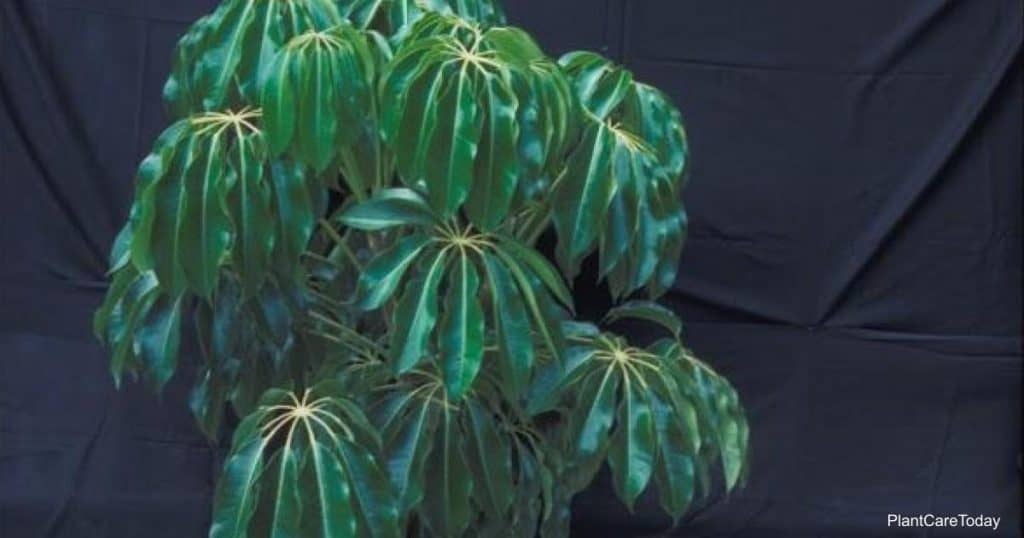Schefflera is a leafy green plant found in the flourishing rainforests of Australia. Schefflera Amate is a select cultivar. It is a perennial, and the pronunciation is as follows: [shef-LER-uh uh-mayt].
Amate is a part of the Schefflera plant genus, a member of the Araliaceae family. The botanical name of Schefflera Amate is Schefflera Actinophylla ‘Amate.’

Common names include:
- Octopus Tree
- Australian Ivy Palm
- Umbrella Tree
It is the “big brother” to the popular Dwarf Schefflera arboricola. The name ‘Amate’ is named after Archie Amate and California nurseryman.
Schefflera Amate Care
Size & Growth
When in the wild, the Octopus Tree is capable of growing 50+ feet. The glossy leaves can grow 3″-6″ inches wide and over 14″ inches long.
The Schefflera amate’s growth rate is a medium pace, ensuring it won’t grow too quickly for you to keep up with maintenance.
The amount of care that the Schefflera Amate gets will determine its size – forgoing regular maintenance results in a larger Schefflera.
NOTE: Amate with its giant umbrella green leaves is one of the more popular large-sized houseplants. It is often used in commercial indoor plant projects.
Flowering & Fragrance
The Schefflera amate blooms a deep red flower less than one inch in size. This plant’s flowering pattern is how it earned its nicknames, the Octopus Tree and the Umbrella Tree.
The flowers are plentiful and colorful on a Schefflera in its natural habitat.
Most blooming appears only on Schefflera in the wild, with houseplants rarely producing. If cared for properly, however, it is not impossible to see flowering on an indoor Schefflera.
Bright Light Conditions & Temperature
For at least 6 hours a day, the Schefflera amate requires bright indirect light.
Between 65° and 90° degrees, Fahrenheit will produce the best results for your Schefflera though it can withstand no damage as low as 35° degrees and as high as 105° degrees Fahrenheit.
‘Amate’ does not stretch as much as the regular Schefflera and holds its leaves very well, even under low light interior conditions.
Water & Feeding
It would be best if you watered your Schefflera daily, with less maintenance in the winter. Due to the high heat and temperatures of the summer, it requires more water during this time.
Soil & Transplanting
The Schefflera amate can thrive in a multitude of soils. Clay, loam, and sand are all suitable options.
Your soil should remain slightly moist though not overtly so. Your Schefflera requires an adequate drainage system to stay healthy.
Overwatering can lead to root rot.
Grooming & Maintenance
While the Schefflera Amate may grow up to 50′ feet in the wild, proper grooming and maintenance will produce an excellent houseplant. If pruned regularly, a Schefflera’s size is capable of being reduced.
Maintaining this schedule will provide you with a flourishing Schefflera Amate. If unpruned, prepare for a more massive tree. Remember to keep in mind the grooming and maintenance that come with owning a Schefflera Amate.
How to Propagate Schefflera Amate
The main methods for propagating the Schefflera Amate include tissue culture, cuttings, seeds, and air layering. Layering is considered the most successful process, especially for those doing it at home.
Cutting involves taking a piece of your Schefflera plant and planting that in hopes of sprouting. When rubbed on your cuttings and stems, there are hormone treatments available that can aid in propagation.
Layering is achieved by scratching a stem from your plant and applying the hormone treatment before bending said stem into an adjacent pot of soil. Once a new Schefflera has begun sprouting from your stem, sever it from your original and repot it.
Of course, seeds require planting and caring for the seeds of your Schefflera amate in hopes of growth. Each method takes time but can produce new plants.
Schefflera Amate Pests or Diseases
The Schefflera is not immune to pests and disease. The Schefflera is most affected by aphids, mealybugs, mites, and scales.
One of Amate’s best traits is its resistance to mites. Mites still attack but have a more difficult time penetrating the thick glossy leaves.
Pests
Feeding aphids can produce mold in your Schefflera as well as stunting your plant. They are often easily noticeable though they may produce sooty mold. Use Neem oil to control the Aphids.
Mealybugs are visible, white spots near roots and the leaves nearby. Mealybugs can result in the death of your Schefflera Amate if not taken care of swiftly. In contrast, mites are often undiscovered until there is severe damage to your Schefflera. A difference in your leaves is a clear sign that mites have infested your plant.
Tips on Controlling Mealy Bugs on Schefflera
Scales begin feeding on your Schefflera Amate until it starts dying. They are sometimes hard to see, resulting in elongated damage to your plant.
Remember to use pesticides on your Schefflera amate when there are pests at hand.
Diseases
In the way of disease, your Schefflera Amate may suffer from a fungal or bacterial infection. Pseudomonas leaf blight and Alternaria leaf spot are the most common.
Pseudomonas leaf blight develops sopping wet areas on your leaves that quickly results in leaf dropping. Your plant will begin to look limp and less full.
Alternaria leaf spot is present when your leaves develop deep, dark spots and begin to fall out. Your Schefflera Amate may start to look sparse and empty, similar to a Schefflera Amate suffering from Pseudomonas leaf blight. The simple fix to this is to keep your leaves dry.
Do Your Research
Consider all possible scenarios when adding a new plant to your home! The temperature, sunlight, and care you can provide your plant will be the determining factors in whether it flourishes or not.
A plant is another living creature that deserves care and maintenance, so ensure you can provide the time and commitment a Schefflera Amate requires.
